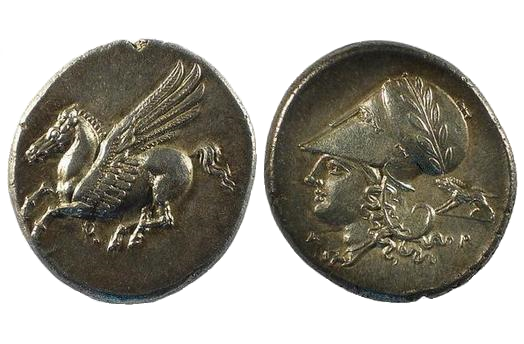
about ancient nomos
Ancient Nomos Art is a museum of galleries exhibiting ancient coins and ancient mint maps. The coin gallery displays the diverse art and history of hand-crafted ancient Greek, Roman, Byzantine, Persian and Medieval coinage. The ancient mints mapping gallery features Greek, Roman, Byzantine, Asia Minor and Medieval mint city regions and territories. Visitor's are welcome to explore, study and enjoy Ancient Nomos Art.

Greek, Corinthia – 345 BC
Corinth
From Ancient Galleries

Obverse: Winged Pegasus flying to the left with koppa symbol for Corinth below.
Reverse: Head of Athena wearing wreathed Corinthian helmut; boar behind.
LEGEND SYMBOLS
Obv. Winged Pegasus flying left; koppa symbol below. Rev. Helmeted laureate head of Athena to left, with small Boar running left behind head; A-P to either side of neck.
The ancient city of Corinth is located on the narrow peninsula of land joining the Peloponnesus with mainland Greece. From at least the 7th century BC, Corinth was Greece’s richest trade port because of its access to both the Aegean and the Adriatic seas. Her emblematic coins depict a winged horse Pegasus, goddess of wisdom and of the sea, and Athena, the warrior goddess and of wisdom. The mythical flying Pegasus is said to have been born of the goddess Medusa, and Poseidon the father, just before Medusa was killed by Perseus. Ancient legend tells us that Bellerophon captured Pegasus, with the aid of a golden bridle given to him by Athena, thus was able to tame her and become first ruler of all Corinth. Corinth issued the earliest Pegasus design concept during the late 6th century and was able to continue similar varieties for well over 200 years. The artwork on the coin above is particularly exquisite and highly refined, portraying Pegasus with hooves bounding aloft and sweeping upwards in flight with an intricate detail of individual feathers engraved on her skillfully sculpted wings. The usual archaic Greek letter koppa appears below Pegasus indicating the city Corinth as the originating mint. The reverse features Athena’s head facing left, wearing a laureate Corinthian warriors helmet, tilted slightly back over a leather cap. The beautiful engraving displays her well defined locks of hair flowing in the wind and sharp facial features in the ancient Greek ideal. The Greek letter A appears before Athena’s neck and P behind her neck, indicating the initials of the issuing chief magistrate. Typical of the later Corinthian staters are the symbols, animals and deities appearing in the fields around Athena. This coin bears a well defined Boar running left behind her head. Some suggest these images are characteristic symbols of ancient Corinth life, a mythological sign of the city, or perhaps animals and dieties associated with sacred religious worship.
DOCUMENTATION
Value: Stater. Metal: AR Silver. Weight: 8.58 grams. Mint: Corinth, Corinthia. Date: circa 345-307 BC.
Attribution: Pegasi I pages 264, 435; Oscar Ravel, Les Poulains de Corinthe 1017; Sear 2629; Weber, Plate 137, 3721 (same dies).
Legend, Documentation and Attribution
